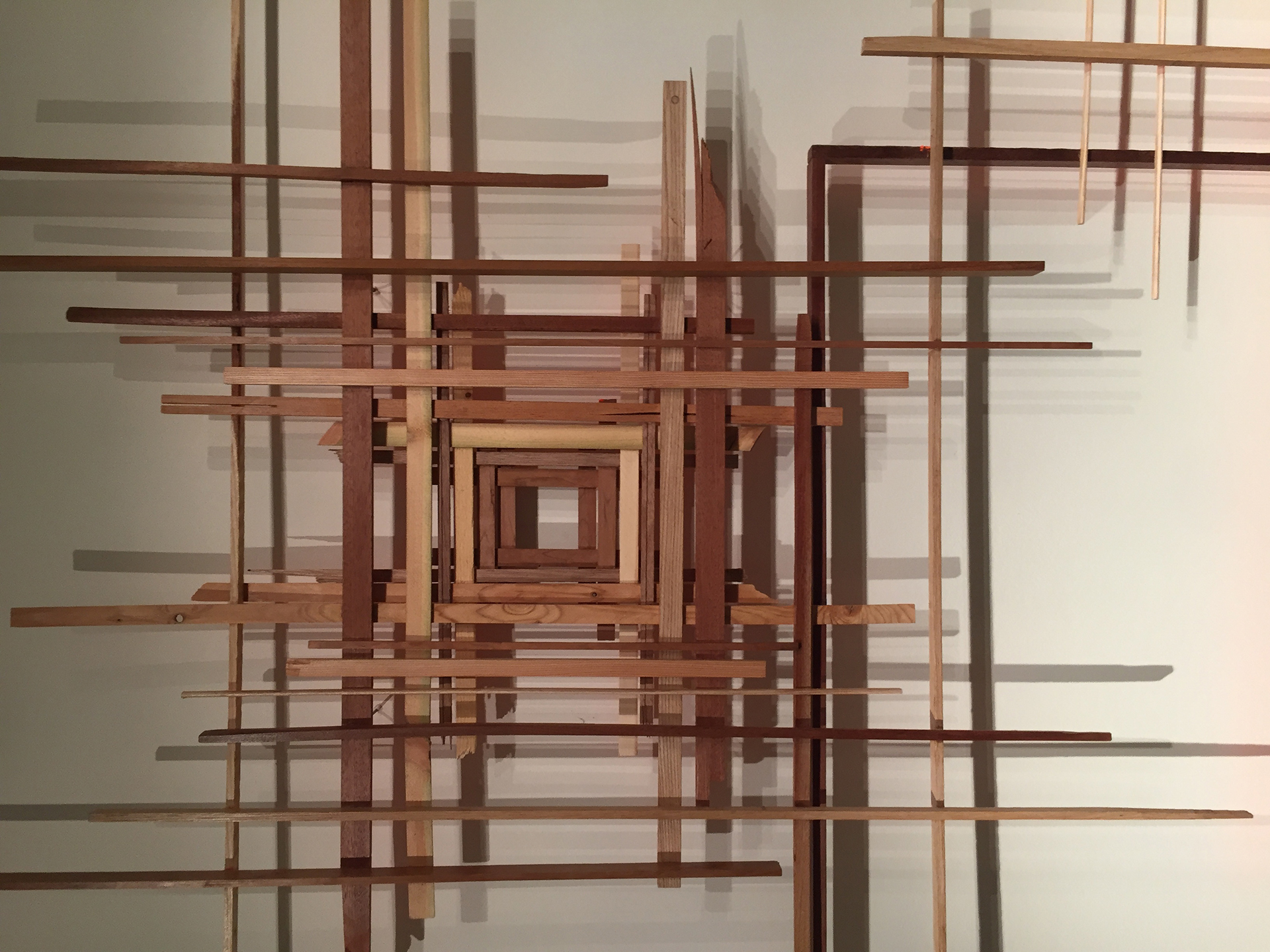
Synjun
SYNJUN, forrými Hallgrímskirkju, 2018
Í verkinu Synjun, sem sett er upp í forrými Hallgrímskirkju nú á nýhafinni Góu, vinnur Kristín með við, sem fenginn er úr ruslakompu trésmiðju og ber því á táknrænan hátt tilvísun í tilvistarlega stöðu flóttamanna, sem eru afgangs og aflóga á flótta sínum frá styrjöldum í heiminum. Viðurinn er í formi fínlegra og viðkvæmra lista af ýmsum tegundum trjáa, bæði harðvið og mjúkum við, dökku tré og ljósu, sem átt hefur rætur og vaxið hefur á ólíkum stöðum og við ólík skilyrði, en hefur á þessum tímapunkti skilað sér upp á Íslands strendur. Viðurinn er óvarinn og með sýnilegar æðar, rétt eins og á manneskjum. Listarnir eru settir saman í geómetrísku mynstri sem minnir bæði á kristið krossform, en líka á krossa sem haka þarf í á endalausum eyðublöðum sem tengjast umsóknum um hæli. Krossformið er hengt á vegg í anddyri kirkjunnar með ákveðna fjarlægð frá fletinum, svo grillir í vægt ómandi endurvarp sterkappelsínugulrar húðar á bakhliðar þess, með tilvísun í litinn sem notast er við í neyð, svo sem í neyðarskýlum, -bátum og -vestum Björgunarsveita landsins. Krossarnir eru jafnmargir þeim sem vísað hefur verið úr landi til þessa. Á veggnum andspænis krossunum standa gegnheil form úr renndum viðarbolum, sem minnt geta á þanin móðurbrjóst, full af hlýju og kærleik. Viðurinn ber enn merki um börkinn sem verndar og umlykur mjúkt tréð, og formið er lífrænt og óreglulegt, sem vísar í persónuleg tengsl lífgefandi mjólkurgjafar móður til barns. Brjóst Maríu eru sjö talsins, tala sem hefur sterk tengsl við kristna táknfræði. Upp við þriðja veggflötinn hangir tvívíð mynd af risastórum hjartavöðva sem skorinn hefur verið út í plastefni með sama neyðar-appelsínugula litinn og tifar í rýminu milli krossanna og veggjarins andspænis. Innsetning Kristínar í Hallgrímskirkju er auðmjúk og fínleg, en jafnframt margræð, þar sem hún ávarpar þann aukna straum flóttamanna sem legið hefur að undanförnu til Íslands, og þeirri miskunnarlausu ákörðun stjórnvalda að vísa meirihluta þeirra af hörku aftur úr landi.
Texti: Guja Dögg Hauksdóttir
Grein eftir Rögnu Sigurðardóttur sem birtist í Artzine 07.05. 2018.
artzine.is/um-samud
REFUSAL in the lobby of Hallgrímskirkja, 2018
In her work Refusal, which is now on display the lobby of Hall – grímskirkja, at the beginning of the old month of Góa, Kristín works with wood sourced from the lumber shed of a carpentry shop – thus symbolically referencing the existential status of refugees, who are left-over and surplus in their flight from war-torn regions of the world. The wood is used in the form of delicate, fragile laths of various types of timber – hardwood and soft, dark and light – which had roots and grew in different places in in vary – ing conditions, to finish up on the distant shore of Iceland. The wood is untreated, with visible veins – like a human being. The laths are assembled into a geometrical pattern which recalls the shape of the Christian cross, and also the crosses that must be checked on the endless application forms that must be filled out by applicants for asylum. The cruciform piece is hung on a wall in the church lobby, slightly away from the surface, giving a faint reflection of the bright orange coating on the reverse that references the colour of emergency: the orange-coloured shelters, lifeboats and lifevests of Iceland’s search and rescue teams. The number of crosses in the work is equal to the number of refugees who have been deported from Iceland. On the opposite wall are solid forms made of turned logs, which are reminiscent of swelling maternal breasts, full of love and affection. The wood still shows traces of the bark which envelops and protects the soft interior of the tree; and the form is organic and irregular, evoking the personal bond entailed by the mother’s life-sustaining breastfeeding of her child. Mary’s Breasts are seven in number – a number which is strongly linked to Christian semiotics. Against the third wall hangs a two-dimensional image of a huge heart muscle, cut into sheet plastic in the same emergency-orange colour as resonates in the space between the crosses and the opposite wall. Kristín’s installation in Hallgrímskirkja is modest and delicate, and at the same time enigmatic, addressing the issue of the increasing flow of refugees to Iceland, and the merciless determination of the authorities to brutally expel most of them from the country.
Text by: Guja Dögg Hauksdóttir











